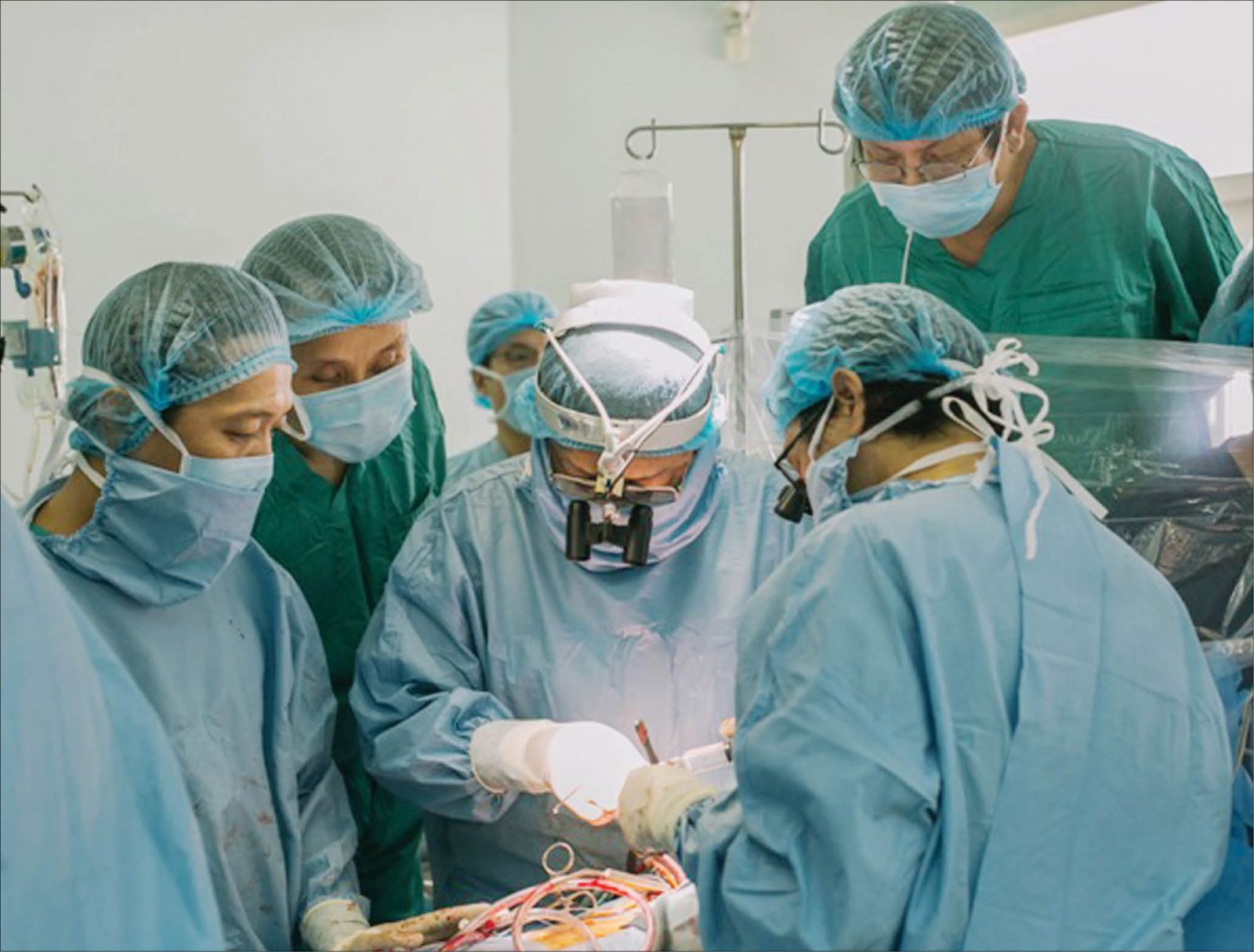
Doctor Dang The Uyen (in the last row) closely watched and monitored hemodynamic parameters of the patient during the "Trans-Vietnam" heart transplant in May 2018 at Hue Central Hospital.
The tension throughout the surgery of the patient
At the Department of Anesthesiology and Reanimation, Cardiovascular Centre, Hue Central Hospital, the working atmosphere is always a state of tension. Doctors go to each and every bed to treat patients for resuscitation. The specialized doctor Dang The Uyen, Head of the Department explained that it was a profession requiring "early arrival, late stay" and putting surgeons’ names in the “hall of fame".
Dr. Uyen explained that in every surgery, the anesthetic team always have to go to the operating room first to assess the patient's condition, performing pre-anesthesia steps, starting the anesthetic procedure for the patient. After anesthesia is completed, the patient would fall into coma, then comes the work of surgeons...
After the surgery, surgeons could remove gloves and sterile gown, but the anesthetic team have to take the patient to the recovery department. At this time, the patient enters "part 2" of the treatment process, called post-op pain relief process.
With nearly 30 years of experience in the profession, Dr. Uyen firmly claimed that the anesthesiology required doctors to always be serious and accurate. Only a very small mistake could lead to severe complications that cost the life of the patient.
“Especially after the surgery, the patient falls into a very weak state, only a small change in the heart rate, and in the patient's blood pressure, all put the whole team of anesthesiologists under pressure of the “tension and perspiration”.” said doctor Uyen.
Dr. Tran Van Duc, Head of Department of Anesthesiology and Reanimation, Phu Vang District Hospital shared that in every surgery, anesthetic doctor always kept their eyes on patients, especially during the operating, to closely monitor and to adjust the appropriate dose; and any vital signs including pulse, blood pressure ... After the surgery, the anesthetic doctors continued their job, helping the patients with gradual awakening, naturally breathing, being conscious and able to feed themselves.
For more than 12 years in this specialty, doctor Duc said that, in order to ensure safety of the operation, the anesthetist must evaluate and monitor the patient not only based on the knowledge but also by the sensitivity and the experiences in the field. When performing general anesthesia for children or babies, there must be absolutely no mistakes even the minor one.
Being asked about the reason, doctor Duc explained that the body structure of infants was not as developed as adults. Therefore, the process of general anesthesia would cause laryngospasm, increasing the risk of death.
Saving many patients in severe condition
Over the period, in the surgeries of severe cases in Hue Central Hospital, there has been an important contribution of the team of anesthesiologists in the Cardiovascular Centre. At this center, an average of 5,000 open-heart surgery and coronary intervention each year were performed, including more than 200 cases with congenital heart defects.
The team of doctors at the Department of Anesthesiology and Reanimation have accompanied to create a safe "pedestal" helping surgeons confidently and successfully complete each surgery, including many cases of children with congenital heart defects who had been born for a few days and their weight were even less than 2kg…
The happiest thing for anesthetic doctors of the Cardiovascular Centre was that they have recently contributed a lot to Hue Central Hospital in successfully performing "trans-Vietnam" heart transplantation, making it the leading brand name in the field of organ transplantation in Vietnam.
Dr. Tran Hoai An, Director of Cardiovascular Centre, Hue Central Hospital, said that among the recent “trans-Vietnam” heart transplants, the captain of the anesthetic team could not be anyone else other than Dr. Dang The Uyen. When being asked about "trans-Vietnam" heart transplants, Dr. Uyen said that these were the quintessence of Vietnamese and international medicine, including the important role of the team of anesthesiologists.
Despite the complications of heart transplants, and with the race were counted in seconds, the team of anesthesiologists had to put patients under cardiac arrest, using ECMO, adjusting the suitable parameters for the patient to propitiously coordinate with the transplantation team, preventing every minor mistake.
Most patients regained consciousness after just one day after transplantation. One of these examples was a heart transplant on June 14, 2018 for patient Pham Van C. (15 years old, Da Nang City), suffering from end stage heart failure with the remaining time counted in days. Until now, C. has stayed healthy and occasionally visited doctors at the department.
Doctor Tran Van Duc has been senior in "combating" on the line between life and death of many surgeries at Phu Vang Hospital. His great devotion hasn’t allowed any complications to happen, even in emergency cases. There have been many surgeries where the lives of children were likely impossible, but with determination, anesthesiologists and other doctors had timely managed to save lives in those severe situations.
According to Dr. Dang The Uyen, every career had its own ups and downs, after choosing, doctors had to dedicate themselves to the job, considering the lives of patients as the top priority. The greatest happiness of anesthesiologist was to witness many patients safely recovered, returning to their normal life ...
Unlike other countries, in Vietnam, after surgeries, anesthetic doctors are less known by patients and their family members than surgeons. The anesthesiology is a quiet job, with " early arrival, late stay " in every case; meanwhile, they are said to be a ladder for surgeons to reach for their height of fame called "the golden hands".
Story and photo: MINH VAN